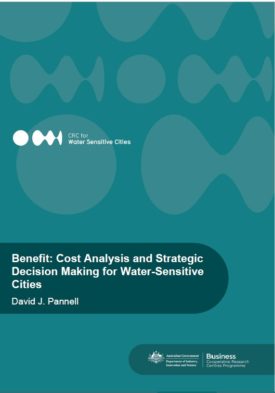Benefit: Cost Analysis and Strategic Decision Making for Water-Sensitive Cities
Introduction
Benefit: Cost Analysis (BCA) is widely used to support decision making about investments in projects or policies, and to underpin business cases for investment (Brent 2006; Hanley and Barbier 2009). There have been countless applications of BCA, to projects or policies as wide ranging as: wastewater management in Sri Lanka; construction of the Three Gorges Dam in China; hosting the Beijing Olympics; preservation of the Amazon rainforest; an immunisation program for avian influenza; and the Jamuna Bridge project in Bangladesh (Quah and Toh 2011). Clearly, BCA is a highly flexible tool.
The importance of economic analysis is widely recognised within the realm of water sensitive cities. Partners in the CRC for Water Sensitive Cities (CRCWSC), including state government agencies, local governments and water utilities, identified an increased capacity for economic analysis as one of their highest priorities. In response, we have developed the Investment Framework For Economics of Water Sensitive Cities (INFFEWS), including a BCA Tool and a Value Tool (for estimating non-market values).
This report does not provide comprehensive information about BCA and how to conduct it. Instead, this document aims to:
- outline the various components of the INFFEWS BCA Tool and explain their relevance to different user groups
- provide a brief introduction to BCA, including the key challenges of completing a BCA
- provide information to help organisations make strategic decisions about BCAs – whether to commission a BCA, what is required for a BCA to be reliable and useful, what a manager should ask for when commissioning a BCA, and how to interpret and use the results of a BCA effectively
- discuss the role of BCA, and economics more generally, in a balanced and systematic process for making decisions about projects and policies.
This document is part of the package of materials that make up the INFFEWS BCA Tool (Box 1). The INFFEWS BCA Tool has been developed as part of a broader project on the economics of water sensitive cities, funded by the CRCWSC.
